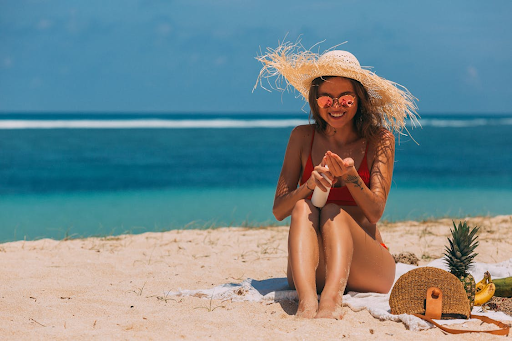Summer is in full swing during the beautiful month of July. But did you know that July is also known as UV Safety Month? It’s a perfect time to educate ourselves and others about the importance of sun protection and why we should all try our best to keep our skin safe. This information can help us have fun outdoors while reducing the health risks that the sun’s ultraviolet (UV) radiation can pose to our health.
So what exactly does UV safety look like? Keep reading to learn more about UV radiation, the importance of UV safety, and tips for staying safe while out in the sun!
What are UV Rays?
To understand why protecting ourselves from UV radiation is important, we must first know what it is. UV radiation is part of the natural energy produced by the sun. Since UV light has shorter wavelengths than visible light, your eyes can’t see it, but your skin can feel it.
Unfortunately, UV radiation is a proven human carcinogen, causing basal cell carcinoma (BCC) and squamous cell carcinoma (SCC). These cancers often appear on sun-exposed areas of the skin. Exposure to UV radiation that results in sunburn can play a role in developing melanoma, a dangerous type of skin cancer. Thankfully, if discovered and treated early, these common skin cancers are typically curable.
Our sun gives off many kinds of UV radiation or rays, such as UVA, UVB, and UVC. UVC rays get absorbed by the Earth’s atmosphere, but UVA and UVB rays can actually get into our skin and cause us harm.
UVA Rays: Did you know that UVA radiation makes up 95% of all the UV rays that make it to the Earth’s surface? They can penetrate deep into our skin and can even pass through glass! UVA rays have a longer wavelength and are associated with skin aging. They are responsible for skin tanning and also skin aging. Unfortunately, there is no such thing as a safe or healthy tan as UVA radiation is proven to contribute to the development of skin cancer.
UVB Rays: Although UVB radiation only makes up 5% of the UV rays from the sun, it is very high energy. It can’t penetrate our skin as deeply as UVA, but it can cause significant damage to the top layers of our skin. Overexposure can lead to sunburns and even blistering. UVB damage will change depending on how strong the sun’s rays are. It is usually the most damaging from late morning to mid-afternoon in temperate climates.
Why is UV Safety Important?
As you can see, UV radiation can be very harmful to human skin. Protecting ourselves from these rays is critical for our health and well-being. By doing so, we can reduce our chances of developing skin cancer. The leading cause of this condition is overexposure to UV radiation.
Protecting the skin from UVA rays is essential for people interested in maintaining a youthful appearance. By shielding the skin from these rays, it is easier to keep the skin healthy and reduce the appearance of wrinkles, fine lines, and age spots. Additionally, our eyes can also get damaged by UV rays which lead to conditions such as cataracts and corneal sunburn. Wearing UV-protective sunglasses can help guard us against these health risks.
What Does UV Safety Look Like?
Thankfully, there are many great ways to protect ourselves from the sun’s harmful UV radiation. A major component of sun protection is broad-spectrum sunscreen. Look for one with an SPF of 30 or higher and apply it to any parts of your skin that will be exposed to the sun. Make sure to reapply sunscreen after two hours or more frequently if you’re swimming or sweating.
Protective clothing is also very important for sun safety as it can shield your entire body from potential harm. Make sure to wear wide-brimmed hats and sunglasses that are designed to block both UVA and UVB rays. If you can avoid being outdoors when the sun is at its strongest, that can also help in reducing health risks. Try to avoid direct sunlight between 10 am and 4 pm if possible, and look for shade in which you can stay.
Conclusion
With July being UV Safety Month, we hope you will take the time to protect yourself when out in the sun. By understanding the risks and dangers of UV radiation, we can make smarter decisions and reduce our risk of developing skin cancer, premature aging, and eye damage. Make UV safety a regular part of your life and make sure to educate and protect your family members as well.

